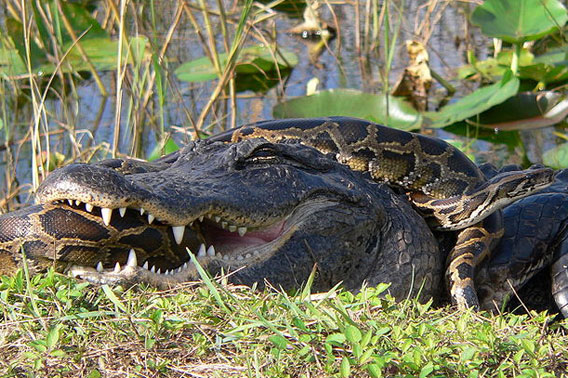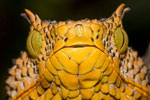
An American alligator and a Burmese python struggle in Everglades National Park. Photo by: Lori Oberhofer, U.S. National Park Service.
Last week the U.S. Fish and Wildlife Service (USFWS) announced it was banning the importation and sale across state lines of four large, non-native snakes: the Burmese python (Python molurus bivittatus), the yellow anaconda (Eunectes notaeus), and two subspecies of the African python (Python sebae). Although popular pets, snakes released and escaped into the wild have caused considerable environmental damage especially in the Florida Everglades.
“Unwitting individuals are buying these animals only to later realize they can’t keep a six-foot-long snake in their homes. They dump them in the wild, where they breed and feed on native birds and other wildlife,” explains George Fenwick, President of American Bird Conservancy (ABC).
In addition to preying on numerous bird species, these massive snakes are known to eat animals as big as deer and alligators in the Everglades.
“It does us no good to put in these billion dollars of investment in the Everglades only to have these giant invasive constrictor snakes come in here and undo the good that we are doing,” Interior Secretary Ken Salazar said on announcing the ban.
The four snakes in question will now fall under “injurious animals” in the Lacey Act. Still, some fear the ban does go far enough as it leaves off five other problem snakes including boa constrictors, though such a ban could come down later.
Pet sellers, however, have complained that a national ban goes too far.
“They have a problem in southern Florida with Burmese pythons and they’re treating it as a national threat, which is silly,” Kevin McCurley a commercial pet dealer in New Hampshire told the Eagle Tribune. “These animals have no chance of surviving in New Hampshire. If you let them go right now in the winter, they would only last an hour.”
Fenwick, however, says that caution is needed given the scale of damage these invasive species can cause.
“This was a decision that had to be made. Populations of long-lived and reproductively prolific invasive snake species, such as the Burmese python, represent an ecological and economic disaster that can quickly overtake even the most far-reaching eradication efforts to protect endangered and declining species,” he said.
Related articles
The dark side of new species discovery

(12/21/2011) Scientists and the public usually rejoice when a new species is discovered. But biologist Bryan Stuart has learned the hard way that the discovery of new species, especially when that species is commercially valuable, has a dark side-one that could potentially wipe out the new species before protections can be put in place. Stuart has discovered 27 species unknown previously to scientists – so far. That includes 22 species of frogs, three types of snakes, and two salamanders. His experience with one of these, a warty salamander from Laos with striking markings (Laotriton laoensis), opened his eyes to a dark side of scientific discovery: commercial overexploitation before protections are in place. Shortly after Stuart described the previously unknown species Paramesotriton laoensis in a scientific paper published in 2002, commercial dealers began collecting this Lao newt for sale into the pet trade. In essence, the dealers used Stuart’s geographic description in the paper as a “roadmap” to find the rare newt.
New large horned viper discovered, but biologists keep location quiet

(12/15/2011) In a remote forest fragment in Tanzania, scientists have made a remarkable discovery: a uniquely-colored horned viper extending over two feet long (643 millimeters) that evolved from its closest relative over two million years ago. Unfortunately, however, the new species—named Matilda’s horned viper (Atheris matildae)—survives in a small degraded habitat and is believed to be Critically Endangered. Given its scarcity, its discoverers are working to pre-empt an insidious threat to new species.
Giant snakes commonly attacked modern hunter-gatherers in Philippines

(12/13/2011) Humans have an ambivalent relationship with snakes. The legless reptiles are often feared and reviled, becoming stand-ins for the Devil and movie monster characters; yet many people have grown to love snakes, raising large, even dangerous, specimens as pets. Now, new research suggests that the ecological role between snakes and humans, as well as other primates, is more nuanced than expected. After spending decades living among the Agta Negritos people in the Philippines, anthropologist Thomas Headland has found that the hunter gatherer tribes were quite commonly attacked by reticulated pythons (Python reticulatus), while the people themselves had no qualms with hunting, killing, and consuming python.